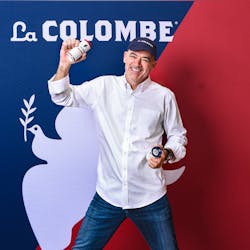Todd Carmichael, CEO and co-founder of La Colombe Coffee Roasters, first learned about coffee through a college job back in 1982. Carmichael and his best friend, JP Iberti (president and co-founder), subsequently started envisioning what the perfect coffee company would look like, and they’ve spent decades building upon that vision. After opening their first café in Philadelphia in 1994, Carmichael and Iberti have grown La Colombe into a company with more than 800 employees and 30 cafes across the country.
More than 25 years later, Carmichael remains dedicated to responsibly sourcing the world’s best coffee, and also to innovation. La Colombe’s ready-to-drink Draft Latte, launched in 2016, features a patented InnoValve® can designed by Carmichael which, upon opening, creates a frothy, texturized beverage that has been flying off the shelves.
Carmichael will deliver the keynote address at the NAMA Coffee, Tea & Water (CTW) event on Nov. 18.
Q: Can you share a little about your history and the founding of La Colombe?
A: I’ll start in 1982 — that’s when I discovered coffee. I’m a farm boy from the eastern part of Washington, and I got the opportunity to go to university. I ran cross-country/ track for the University of Washington. When I got to the big city, I needed a job, and I found one lugging grain sacks in a small warehouse. When I looked at the names on those sacks — Rwanda, Uganda, Tanzania — they weren’t names I recognized. In another part of the building, I saw the roaster, and I went, “Wait a minute.” It was coffee. It was for a really tiny company at the time — they had three cafes — called Starbucks. I was in the right place at the right time. So, I’m like the Forrest Gump of coffee. I was a runner, and I was a little bit thick-skulled [laughs].
While I was in Seattle I met my best friend Jean Philippe [Iberti], and we were concocting the philosophy of what the perfect coffee company would be. We were just kids and we were both broke. The idea was going all the way back to the farm, because I knew that if anyone took the time to get in the truck and come out to our farm, they’d always get the best food. So farm-to-table was really based on this concept, that we could get a higher grade of coffee if we would just take the time to go and get it and create a relationship with farmers.
I was studying business and learned about vertical integration, so I said, “OK, that’s it — let’s vertically integrate. We’ll make everything we sell, and we’ll source directly at the farms.” And that philosophy has taken us pretty far. We know that nothing is ever finished — even coffee — and that you need to take that vertical integration concept and combine it with another idea. So, we opened up our first cafe at the beginning of 1994. We had $200 in our bank account, and we really needed it to work, or we wouldn’t be able to eat. And it did. Today I’m told that we’re valued at somewhere around $1 billion, and we’re growing at about 60 percent.
Q: What role has philanthropy played in the company?
A: It’s not a strategy — it comes from the heart, and it comes from the team. We get involved in lots of different things that speak to us. There’s a group of really talented people in [La Colombe] marketing who feel very passionately about school lunches for kids, so we lean into that. So, it’s really just that. When I hear the word “philanthropist,” I think it’s self-serving because you’re not exceptional … it’s just being normal. Why would you stand out for being normal?
Childhood is really important to me. All my kids come from Ethiopia [Carmichael and his wife Lauren Hart have four adopted children] where their early years were spent in a place where HIV/AIDS was ravaging villages. Before, you wouldn’t see orphanages. They never needed them because family always took care of family, but family was so tattered and so stricken that they needed assistance
If you try to help the world a little bit, it’s an easier thing to do in coffee-growing places. The three areas I picked were Uganda — even though I don’t do a ton of coffee out of Uganda — Ethiopia and Haiti. And then we do some agricultural projects. We have certain requirements; we pay a lot more than most people, and we’ll help you with water. If you’re not providing water to people around you, then we can’t buy your coffee.
At the end of the day, we’re a retailer, too, with 30 cafes. The total company is maybe 800 employees, and our turnover rate is at 1 percent. I have my original 100 employees because the company is decent, and they know it, and because they can get engaged with projects and can say, “Look, we’ve changed the lives of people.” And we have great coffee and we love growing. It creates this environment where you don’t have to sit around all the time figuring out what your brand should be. You just exercise the best part of you, and the brand comes from that.
Q: How has La Colombe elevated the coffee experience, especially at the office?
A: Well, when I started 25 years ago with La Colombe, it was a space we couldn’t go into. The office coffee was free, so people would drink sawdust. But the nature of coffee was changing on the street. The majority of people got coffee from carts or they got coffee in diners, so breaking it from those boundaries and into a brick-and-mortar was the first big step.
And then, obviously, a lot of those folks who are coming into the cafe are professionals. Within a couple of years, we had a couple of law firms come in and say, “We can’t live without this,” so we would do a special thing for them. And then Goldman Sachs in New York came and said, “We have to have the best,” and then we just realized this incredible proliferation.
Then you start asking yourself the question, “What can I do to really put my thumbprint on this space?” Cold brew was a big one. Then RTD (ready-to-drink) became huge. [OCS] is no longer perceived as just a dead cost; it’s seen as a serious perk, and that’s not going to go away. I think that the real glory days with coffee and what it can do in the workspace start right now — they’re just beginning.
Q: What are the most significant challenges facing the industry right now?
A: The huge tectonic shift that has happened here is that we’ve gone from hot to cold. I can’t overstress that enough. I’ve been in coffee since 1982 and I’ve seen changes, but I’ve never seen anything like this.
I’ll give you an example. It was maybe 1996, and someone came into our first cafe in Philadelphia and wanted an iced latte. I thought this man had been hit on the head with a shovel. It was like saying, “Can I have sardines in there?” I made him what I could, and he left, and I thought, “Well, that was weird.” So that year, that was maybe .0001 percent of the coffee sold at the cafe that was cold. Today, it’s 65 percent.
The shift to cold is outrageous and wild for such an ancient product like coffee. The workspace is only touching it slightly — maybe they have a box of it in the refrigerator — but this is going to change. This is changing in the RTD space.
On tap in that environment is the next thing. It’s very simple; you can get 15 gallons of concentrate in a bag-in-box. You push it through a barometric pump, and it comes out delicious. You put it out in a tap that you maybe once used for beer, and you now have a beautiful cold version of coffee that you can’t even touch with a hot machine. Silicon Valley tends to drive the new office concepts, and right now they’re going out of their minds over the cold brew, and so are financial institutions in New York. They’ve got their fingers on the pulse.
Q: Strategically, what’s next for La Colombe?
A: For us, what’s next is a long future. I’d like to see what’s at the end of this road. For me, I’d like to completely disrupt the K-cup space. I think it’s all being done incorrectly, and I believe I have the technology to change everything. I would like to do with the K-cup space what we did with the RTD: make it genuine, make it unbelievably good, make it user-friendly, and make it something that when you drink it, you go, “Wow.” And, you know, I don’t purposely disrupt anything; I just look for innovation. I love change. I like to try to keep ahead.
I’m a bit of a hyperactive, non-sleeper. I have a lab in my basement, I’m constantly going at it, and for me, innovation isn’t just, “Oh, I made a formula and it tastes slightly better than yours,” it’s like, “This is a whole new way of looking at this,” and I like that. It makes me happy.
About the Author

Abby White
Abby White previously served as chief editor for Automatic Merchandiser and VendingMarketWatch.com.
To reach the current editor of Automatic Merchandiser and VendingMarketWatch.com, email [email protected].
